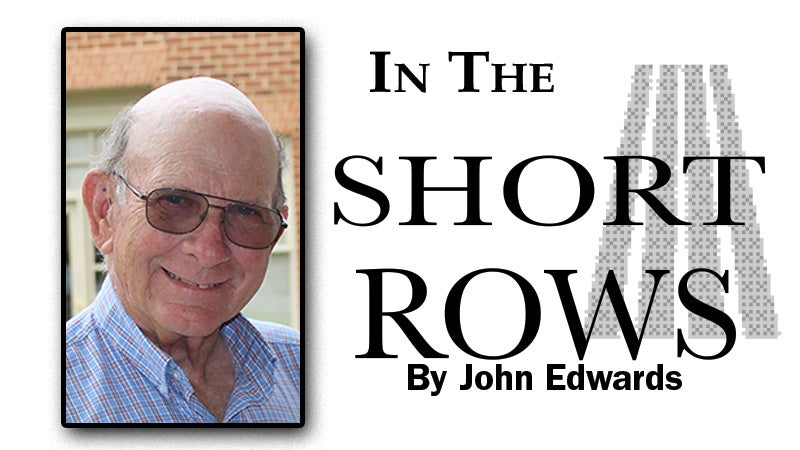Short Rows: Take it from an expert: Old places indeed matter
Published 6:38 pm Wednesday, October 19, 2022

- John Edwards
Anyone who has ever been involved in preserving old buildings or sites, whether intimately or tangentially, or for that matter anyone who has ever visited and been awed by a historic setting, can relate to what Thompson Mayes has to say.
Mr. Mays is chief legal officer for the National Trust for Historic Preservation, and in that capacity he has dealt with multiple legal issues involving preservation of sites owned by the Trust.
Recently, though, he set legal documents aside, took a sabbatical and turned his considerable writing talent as well as his passion for preservation to a series of essays. In the end, what emerged was a book, appropriately titled “Why Old Places Matter.”
Mays’ brief and beautifully illustrated book — a mere 118 pages plus numerous notes — might be dismissed as a “coffee table” volume, but to do so would be a huge injustice, for this work is far more. It amounts to a legal brief that old places do, indeed, matter in our lives.
Mr. Mays brought his book and his passion to Historic St. Luke’s Church recently, at the invitation of the Isle of Wight Historical Society and St. Luke’s.
And where better to talk about the value of old places than in one of Virginia’s oldest. St. Luke’s has survived well into its fourth century — pick a date of construction that suits you, for no one knows for sure. It has withstood the ravages of time, of wars, storms and repeated periods of neglect. Every time it seemed the venerable Old Brick Church would die, passionate local people who revered it came to its aid, launching rescue after rescue. Their fund drives dug deeply into local pockets and at times reached across the nation to save this cherished relic of early America.
So, it was in St. Luke’s that Mays outlined his argument on behalf of those places we value most, be they old churches, old schools, old houses or just pieces of the landscape that hold particular meaning to us.
Mays doesn’t venture too far from his lawyerly approach. He goes through his arguments systematically, ticking off the essays (and book chapters) that encompass what he believes are the values of “old.”
Topping the list, as it should, is continuity. Our lives cry out for it, and the old places with which we relate offer it. But let him express it.
“Old places provide people with a sense of being part of a continuum, which is necessary for them to be both psychologically and emotionally healthy.” Thus, we visit the places of our youth, walk down a familiar street, or into a much-loved church sanctuary or cemetery.
Closely connected to continuity is memory. When a group of local county and town residents undertook the revitalization of Main Street Smithfield more than three decades ago, we didn’t really “preserve” it. That would have entailed going back to an unpaved street and gutters awash with more than rain. What we sought to preserve was the memory of Main Street. In fact, when we approached prospective donors for help in rebuilding the street, we told them the memory of the downtown of our youth and the continuity it provided were primary driving forces in what we were about. They responded positively because continuity and the memory of those times were important.
Mays also believes that old places embody our identity.
“They give us a sense of self. They tell us who we are as a people,” he wrote.
And Mays reminds us that the sense of identity is very personal. The places with which we identify don’t have to be old. Some of us will remember Main Street in its bustling heyday. Younger people may recall time spent in a shopping mall in much the same way,
“Though our identity with place changes over time, the places that form our identity act as tangible objects that support our identity,” Mays concludes.
And then, of course, there is our civic, state, national and universal identity.
Monticello or Mount Vernon may be imprinted in our identity, as are the Statue of Liberty, the Washington Monument and numerous other sites that cry out to us as Americans.
But we are also citizens of the world, though there are those today who would deny it. Who among us doesn’t recognize the history of mankind epitomized by the Acropolis or the great pyramids?
And then, there’s beauty. Mays notes that when asked to list beautiful buildings, most people will generally list old buildings ahead of new.
There is, of course, history. “Places,” be they buildings, battlefields, cemeteries or other sites, bring history alive for us. And when the sites are lost, something of the history associated with them is lost as well.
Old places, Mays also argues, are often sacred to us. Not necessarily religious, but sacred in a very personal sense.
He also argues persuasively that preserving our past is good economics. Preservation creates good-paying jobs and significant local tax revenue. Heritage tourism is a huge industry across the country, including Isle of Wight County. Preservation revitalizes communities, attracts talented people who want to be involved and increases property values.
Finally, every old house or commercial building saved is one less that has to be built. Materials are saved and, Mays argues, that’s even environmentally sound.
Isle of Wight is rich in history and in “old places” of importance. To be reminded of what we have is important, and Thompson Mays did just that. Congratulations to the Historical Society and St. Luke’s for bringing him and his message here.
John Edwards is publisher emeritus of The Smithfield Times. His email address is j.branchedwards@gmail.com.

